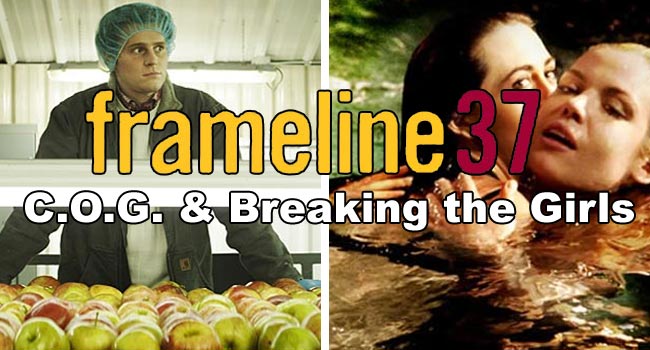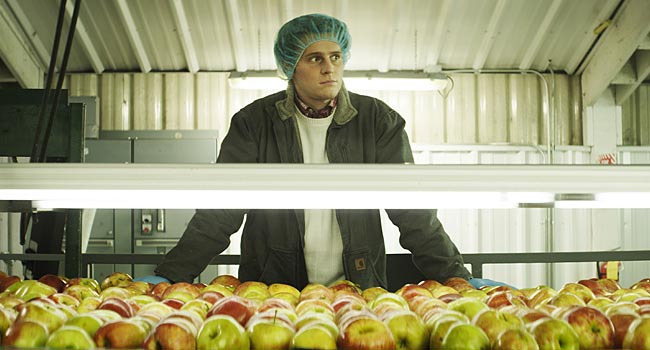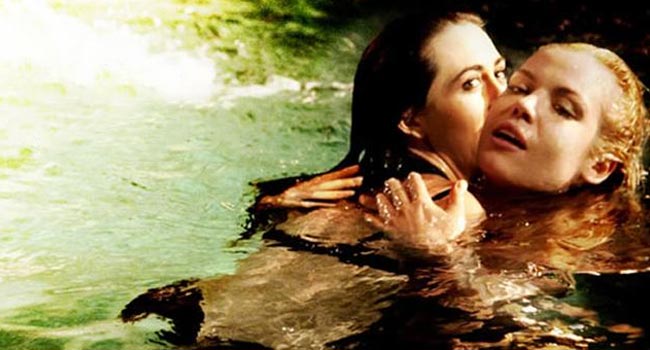Frameline37 Reviews: C.O.G. & Breaking the Girls

C.O.G.

At long last, David Sedaris has allowed one of his essays to be adapted to film. With director Kyle Patrick Alvarez (Easier With Practice) at the helm, C.O.G. is a respectably interesting indie soul-seeker drama, but it’s unfortunately far inferior to Sedaris’ original tale. Alvarez manages to dampen Sedaris’ almost mythical characters with writing that’s thin and unworthy of the source material, though he does extract worthy performances out of his fine cast.
Jonathan Groff plays David, a pompous, preppy Yale student (he lets you know with the “Y” on his sweater) who travels West on a Greyhound with the mission of “getting his hands dirty”, battling his long-repressed homosexuality, and finding happiness. He begins his odyssey by picking apples on an apple farm (beautifully shot), run by the hilariously ignorant Dean Stockwell. Groff’s cockiness is believable, though he never crosses into unlikable territory. There’s a boyish innocence to him that he retains throughout the film, no matter how brash he gets. There’s an interesting mix of sexual and religious confusion wrapped up in David, and Groff conveys the inner conflict nicely.
From here, David gets moving. He’s promoted to the apple sorting plant where he meets a friendly, flannel-wearing, blue collar guy named Curly (played with panache by Corey Stoll) who…well…let’s just say he comes on a little strong. Pretty strong. Very strong. “This is my dildo collection!” strong. David also meets a shit-talking apple-sorter, Debbie (Dale Dickey), and a legless Gulf War vet named Jon (the great character actor Denis O’Hare) who introduces him to the titular trio of letters and attempts to convert him to Christianity.
Jon is a tornado of rage, jealousy, small-mindedness, and unwavering faith, though he’s got enough kindness in him to take David under his wing. It’s a complex, ever-evolving role, and watching O’Hare handle it with such conviction is a joy. The scenes between Groff and O’Hare are the film’s best—their companionship is touching, yet it always feels volatile. The rest of the characters aren’t given much to do, though the actors make the best of what they’re given. The episodic format of the story makes every moment feel transient, fleeting, so that nothing ever really sticks. Characters come, they go, we move on.
Alvarez makes Oregon look divine, with its leafy landscapes and tranquil fields highlighted whenever appropriate. There are several electric moments scattered throughout C.O.G. (mostly involving O’Hare), but the tedious pace of David’s journey is unsatisfactory. Each potential friend David meets turns out to be something shockingly different than what he expected, which feeds the film’s main theme: Everyone’s got fatal flaws, but they deserve to be loved nonetheless. We should love these characters, but with how ambivalently Alvarez presents them, they’re hard to even remember.
RATING: 6.7
Breaking the Girls

Director Jamie Babbit offers up what has got to be tackiest, most titillating version of Strangers on a Train ever made. Agnes Bruckner plays Sara, a driven law student who bartends to pay the bills. On the same night Sara gets fired for stealing from the tip jar (her arch-nemesis, Brooke, ratted her out), an enigmatic seductress named Alex (Madeline Zima) treats Sara to a wild night of debauchery, cathartic plate smashing, and steamy swimming pool sex. During pillow talk, Alex half-jokingly suggests the classic “murder trade” scenario, in which she murders Brooke for Sara, and Sara murders Nina, Alex’s stepmom and bane of her existence. Sara laughs off the proposition, but when Brooke is found dead in the school swimming pool, she finds herself unwillingly entangled in Alex’s murderous plot.
Babbit showed real talent in the cutely clever But I’m a Cheerleader, but Breaking the Girls bears a stronger resemblance to her run on the late-night MTV sex-soap, Undressed. There are a lot of girl-on-girl sex scenes here (more like make-out scenes), but they feel empty and uninteresting. Zima and Bruckner are gorgeous, but these scenes lack any kind of sexiness due to the film’s trashy 90’s TV movie presentation. There’s an irksome yellowish hue to the film that makes everything look “blech”. Even in scenes shot in broad daylight, the mustard tinting made me feel queasy.
The second half of the film gets quite plotty, which is good and bad. Bad, because every revelation, every twist (there are a lot of them, thrown at us rapid-fire) is so convoluted it’s damn near laughable. I’m not one to get hung up on plot holes, but there are so many here it’s dizzying. The good news is that these zigs and zags do generate a respectable sense of momentum, and if you numb your mind to the idiocy of it all for a bit, you might find yourself actually getting caught up in the story. The problem is you won’t be rewarded for your efforts, as the ending we arrive at is predictable and not nearly as emotional as it’s supposed to be.
The sad thing about all this is that the cast is very, very good. Bruckner fits the role of ambitious heroine like a glove, and Zima is as deadly and intoxicating as always. There’s a tricky sense of mischief to her eyes that always seems to draw me in. The always solid Shawn Ashmore is wasted here and amounts to nothing more than a walking plot device. This isn’t a terrible movie, but its ambition is sadly unmatched by its execution, damning it to the land of straight-to-video.
RATING: 5.2
